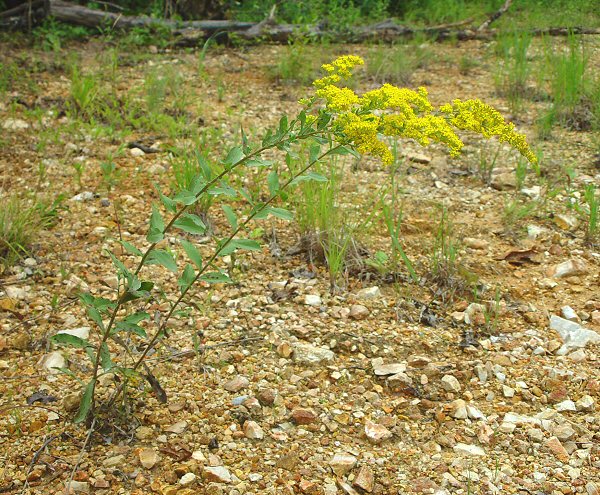Solidago radula Nutt.
Rough Goldenrod

Native
CC = 6
CW = 5
MOC = 67
© DETenaglia
Solidago radula Nutt.Rough Goldenrod | |
 |
Native CC = 6 CW = 5 MOC = 67 |
© DETenaglia |
|
Family - Asteraceae/Astereae Habit - Perennial forb with the rootstock short and somewhat thickened, often also producing branched short-to long-creeping rhizomes. Stems - Loosely ascending to erect, to 1.2 m, single or more commonly multiple from the base, with several fine, longitudinal ridges or grooves, moderately to densely pubescent with short, stiff, mostly spreading hairs 0.1-0.6 mm long, these often broad-based (the stem roughened to the touch) and sometimes sparse toward the stem base, not shiny, not glaucous.
Leaves - Chiefly cauline, the largest leaves about 1/3 of the way up the stem, the basal and lower stem leaves usually absent at flowering. Basal and lowermost stem leaves with the blade 3-10 cm long, 0.7-2.5 cm wide, mostly 4-6 times as long as wide, elliptic-lanceolate to elliptic or elliptic-oblanceolate, occasionally narrowly elliptic-obovate, somewhat thickened and relatively stiff, tapered gradually to a short to long, winged petiole at the base, angled or tapered to a sharply pointed tip, the margins sharply but finely toothed to shallowly scalloped or nearly entire and microscopically roughened to minutely hairy, the surfaces sparsely to moderately roughened with short, mostly spreading, broadbased hairs, the undersurface with 3 main veins, the lateral pair (and midvein) often somewhat raised, usually only slightly more prominent than the other pinnate secondary veins (these forming an irregular network), the veinlets often difficult to observe. Median and upper stem leaves 1-8 cm long, sessile or very short-petiolate, the blade mostly 2-6 times as long as wide, lanceolate to elliptic or narrowly elliptic-obovate, the margins of at least the uppermost leaves entire, otherwise similar to the lower stem leaves.
Inflorescence - Terminal pyramidal panicles, the branches and often also the tip usually arched or nodding, the lowermost branches sometimes relatively long, the heads oriented upward along the branches. Peduncles pubescent, each subtended by 1 reduced bract. Bracts subulate and greenish.
Heads - Involucre 3-5 mm long, the bracts in 3 or 4 unequal series. Involucral bracts oblong-ovate to narrowly oblong-lanceolate and mostly bluntly to sharply pointed at the appressed-ascending tip, the thin, white to yellowish white margins hairy (at least toward the tip), the outer surface glabrous, with an often poorly differentiated, elliptic or narrowly diamond-shaped, green to light green central region mostly above the midpoint, this tapered gradually to the midvein, the midvein often slightly thickened and keeled and no additional veins present. Receptacle naked.
Flowers - Ray florets 4-8, pistillate, the corollas 2.5-4.0 mm long, yellow. Disc florets 4-6, the corollas 2.5-3.0 mm long, the lobes 0.5-0.9 mm long, yellow. Pappus 2.5-3.0 mm long, a few of the bristles often slightly thickened toward the tip.
Fruits - Achenes 1.5-2.5 mm long, narrowly obovoid, finely hairy (sometimes only sparsely so). Flowering - May - October. Habitat - Upland forest openings, bluffs, glades, savannas, roadsides. Origin - Native to the U.S. Lookalikes - S. drummondii. Other info. - This species can be identified in the field by its heavily scabrous, serrate leaves which are typically numerous on the stem and stiff in texture. There are often multiple stems arising from a small area. This plant does not acquire the large size of some of the other species in this genus. It practically always nods like in the plant picture above. It is found across much of the state, excepting the northwestern third. Photographs taken at the Current River Conservation Area, Reynolds County, MO., 7-24-01 (DETenaglia); also at Glade Top Trail National Scenic Byway, Ozark County, MO, 8-16-2023 (SRTurner). |